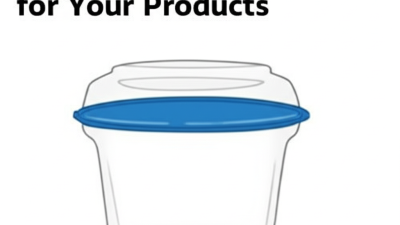How to Choose the Right Clear Clamshell Packaging for Your Products
Clear clamshell packaging has become a popular choice among retailers and manufacturers due to its versatile design and effective product protection. According to a report by Smithers Pira, the global market for clamshell packaging is expected to reach $7.3 billion by 2025, highlighting its increasing significance in various industries including food, cosmetics, and electronics. This type of packaging not only offers visibility and convenience but also enhances consumer engagement by allowing customers to see the product while ensuring its safety and integrity.
 Additionally, its eco-friendly materials and recyclability align with the rising consumer demand for sustainable packaging solutions. As businesses seek to stand out in a competitive market, understanding how to choose the right clear clamshell packaging becomes essential for maximizing both product appeal and functionality.
Additionally, its eco-friendly materials and recyclability align with the rising consumer demand for sustainable packaging solutions. As businesses seek to stand out in a competitive market, understanding how to choose the right clear clamshell packaging becomes essential for maximizing both product appeal and functionality.
Understanding the Basics of Clear Clamshell Packaging: Materials and Benefits
Clear clamshell packaging is a popular choice for various products due to its transparent design, allowing consumers to view items easily while still providing protection. Made primarily from materials such as PET (polyethylene terephthalate) or PVC (polyvinyl chloride), these packages are lightweight yet durable, perfect for packaging everything from food items to electronics.
PET is especially favored for its recyclability, adding an eco-friendly aspect to product presentation.
In addition to material benefits, clear clamshells offer several functional advantages. Their hinged design allows for easy access, making them user-friendly for both retailers and customers. Moreover, the robust structure provides excellent protection from external elements, reducing the risk of damage during transportation and storage. The versatility in shape and size also makes clear clamshells suitable for a wide range of applications, from single items to bundled sets, ensuring that businesses can find a fitting solution to showcase their products effectively.
Evaluating Product Compatibility: How to Match Clamshell Designs to Your Items
When selecting clear clamshell packaging, evaluating product compatibility is crucial to ensure that the packaging properly houses and protects your items. Start by assessing the dimensions and shape of your products. Many clamshell designs are tailored for specific shapes, so it’s essential to find one that fits snugly around your product to minimize movement during transport. Additionally, consider the weight of your items; heavier products may require thicker material to adequately support them without risk of bending or breaking.
**Tips**: Measure your products precisely and use those dimensions to compare with available clamshell options. Opt for clamshell designs that offer extra features, such as locking mechanisms or tabs, to enhance security and prevent accidental openings.
Moreover, think about how your packaging will reflect your brand. The clarity of the clamshell and its visual appeal can significantly influence consumer perception. Choose designs that not only fit your products well but also showcase them attractively to potential buyers. Lightweight designs can enhance product visibility while being easy to handle.
**Tips**: Test different designs with your product before finalizing your choice, ensuring that the packaging reinforces your brand identity while providing necessary protection.
How to Choose the Right Clear Clamshell Packaging for Your Products
| Product Type | Clamshell Design | Dimensions (L x W x H) | Material | Closure Type |
|---|---|---|---|---|
| Gadgets | Full Clamshell | 6 x 4 x 2 inches | PET Plastic | Snap Closure |
| Food Items | Sealable Clamshell | 5 x 5 x 3 inches | PP Plastic | Hinge Closure |
| Cosmetics | Blister Clamshell | 4 x 2 x 1 inches | PVC Plastic | Press Closure |
| Toys | Multi-compartment Clamshell | 10 x 7 x 3 inches | APET Plastic | Locking Tabs |
Exploring Industry Trends: The Rise of Eco-Friendly Clamshell Packaging Solutions
As consumer awareness of environmental impact rises, eco-friendly clamshell packaging solutions are gaining traction in various industries. Manufacturers are increasingly opting for sustainable materials that not only reduce waste but also appeal to environmentally conscious consumers. These innovations are driven by a demand for products that harmonize with green initiatives, leaving behind the traditional plastic packaging that often contributes to pollution.
When selecting transparent clamshell packaging, prioritize materials that are recyclable or made from recycled content. This not only helps in reducing the carbon footprint of your product but also aligns with the values of your customers.
Another essential tip is to consider the design and functionality of your packaging. Ensure that the clamshell is not only visually appealing but also practical in terms of protecting the product inside. Look for features like easy open systems or additional compartments that enhance usability while minimizing material waste. By focusing on these eco-friendly options, businesses can contribute positively to the environment while attracting a wider customer base.
Cost-Benefit Analysis: Balancing Quality and Budget When Choosing Clamshells
When selecting clear clamshell packaging for your products, conducting a cost-benefit analysis is essential to find the right balance between quality and budget. High-quality clamshells can provide enhanced durability and protection for your items, ensuring they arrive in perfect condition. However, these premium options often come with a higher price tag. Assessing the potential return on investment is crucial; consider whether the added protection and attractive presentation will lead to increased sales or customer satisfaction.
On the other hand, opting for more budget-friendly clamshells might save you money initially, but it’s important to evaluate the potential trade-offs. Lower-quality packaging may result in increased damage during transport or a less appealing product display, which can negatively impact your brand’s perception.
It is vital to consider the overall lifecycle costs, including packaging, shipping, and potential returns, to ensure that your choice supports long-term profitability while meeting consumer expectations. By carefully weighing these factors, you can choose clear clamshell packaging that aligns with both your quality standards and budget constraints.
Regulatory Compliance: Ensuring Your Packaging Meets Industry Standards and Safety Regulations
When selecting clear clamshell packaging for your products, regulatory compliance plays a crucial role in ensuring that the packaging not only serves its purpose but also meets industry safety standards. Various regulations, such as those set by the FDA for food products and ASTM guidelines for materials, dictate the types of materials that can be used and their overall suitability for specific applications. It is essential to thoroughly understand these regulations to avoid costly compliance issues down the line.
In addition to understanding regulatory requirements, consider conducting regular audits of your packaging suppliers to ensure their materials comply with safety standards. This involves scrutinizing their certifications and ensuring that the materials used in your clamshell packaging are free from hazardous substances.
By prioritizing regulatory compliance, you not only protect your customers but also enhance the credibility of your brand in the marketplace. Ultimately, meeting these industry standards can lead to increased consumer trust and potentially higher sales.
Related Posts
-

Essential Checklist for Choosing the Right Plastic Clamshells for Your Products
-

Ultimate Guide to Mastering Clam Packaging for Global Buyers
-

Exploring Innovative Alternatives to the Traditional Blister Packing Machine
-

How to Choose the Right Stock Blister Packaging for Your Products
-

Ultimate Checklist for Optimizing Your Thermoforming Plastic Production Process
-

What is the Importance of Blister Packaging Machine in Modern Manufacturing
